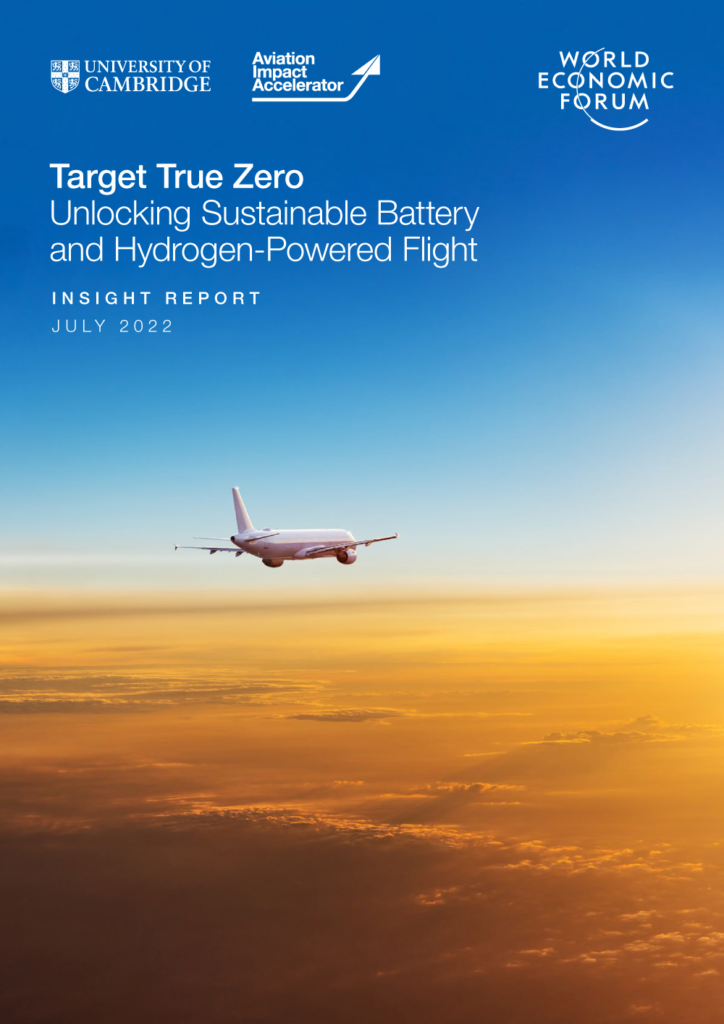Publications
The 2030 Sustainable Aviation Goals
Five Years to Chart a New Future for Aviation
This report outlines an ambitious five-year plan for the aviation sector. It establishes four pivotal 2030 Sustainable Aviation Goals, each targeting key leverage points. If these goals are not implemented immediately and achieved by 2030, the opportunity for transformation will slip away, leaving the world to face the escalating climate impacts of a rapidly growing aviation sector, which is projected to at least double by 2050.
Citing this report:
Aviation Impact Accelerator, 2024. Five Years to Chart a New Future for Aviation: The 2030 Sustainable Aviation Goals [R.J. Miller, E.N. Whittington, S. Gabra, P.J. Hodgson, J. Green, J. Kho, J.R. Smith, D. Singh]. AIA, University of Cambridge.
Target True Zero
Unlocking Sustainable Battery and Hydrogen-Powered Flight
This insight report, developed by the World Economic Forum and the Aviation Impact Accelerator and with a Foreword from His Royal Highness the Prince of Wales, seeks to assess the total climate impact of battery-electric aircraft, hydrogen fuel cell electric aircraft and hydrogen combustion aircraft, and identifies critical areas of uncertainty. The report examines the technical capabilities and challenges of these novel technologies and the role they might play in accelerating the aviation industry’s sustainability efforts.
Citing this report:
Barker, B., Hodgson, P., Hyde, D., Miller, R., Rapeanu, M., Target True Zero: Unlocking Sustainable Battery and Hydrogen Powered Flight. World Economic Forum, 2022.
Download the insight report here.
Find the report on the World Economic Forum website here.
World Economic Forum Article
How hybrid planes could make aviation more sustainable
This article, written in collaboration with the World Economic Forum, discusses how hybrid aircrafts can improve the range limitations of battery-electric planes and accelerate regional/short haul aviation’s journey to sustainability. However, the potential for emissions reduction largely depends on the sustainability of battery production and charging processes. The article also describes the benefits of hybrid aircrafts to the airports, which include noise reduction and improvements to local air quality.
Citing this article:
Gribbin, E., & Singh, D. (2024). How hybrid planes could make aviation more sustainable. The World Economic Forum
Find the article on the World Economic Forum website here.
Find the article on the AIA website here.
Tools
The AIA has developed dynamic tools for a variety of different audiences, which are used to inform industry, policymakers and public to drive positive change on an organisational and sector level. These include CRAFT– a scenario-based tool to analyse different decarbonization transition pathways for aviation, CELESTE -a tool to estimate the climate impact of contrails formed by a flight, JIST -a tool that allows users to explore flights between two airports at present and in the future, helping them understand the pathways to net zero aviation, Contrailkit – a public engagement mobile application that allows users to record real-time contrails. Following is one of our public tools called RECCE. For more information on other tools, please get in contact through email: info@aiazero.org
Resource to Climate Comparison Evaluator
RECCE can be used to directly compare alternative aviation fuels based on their climate impact, resource requirement and costs. The tool provides a detailed breakdown of where in the system emissions occur and where the uncertainties are.



